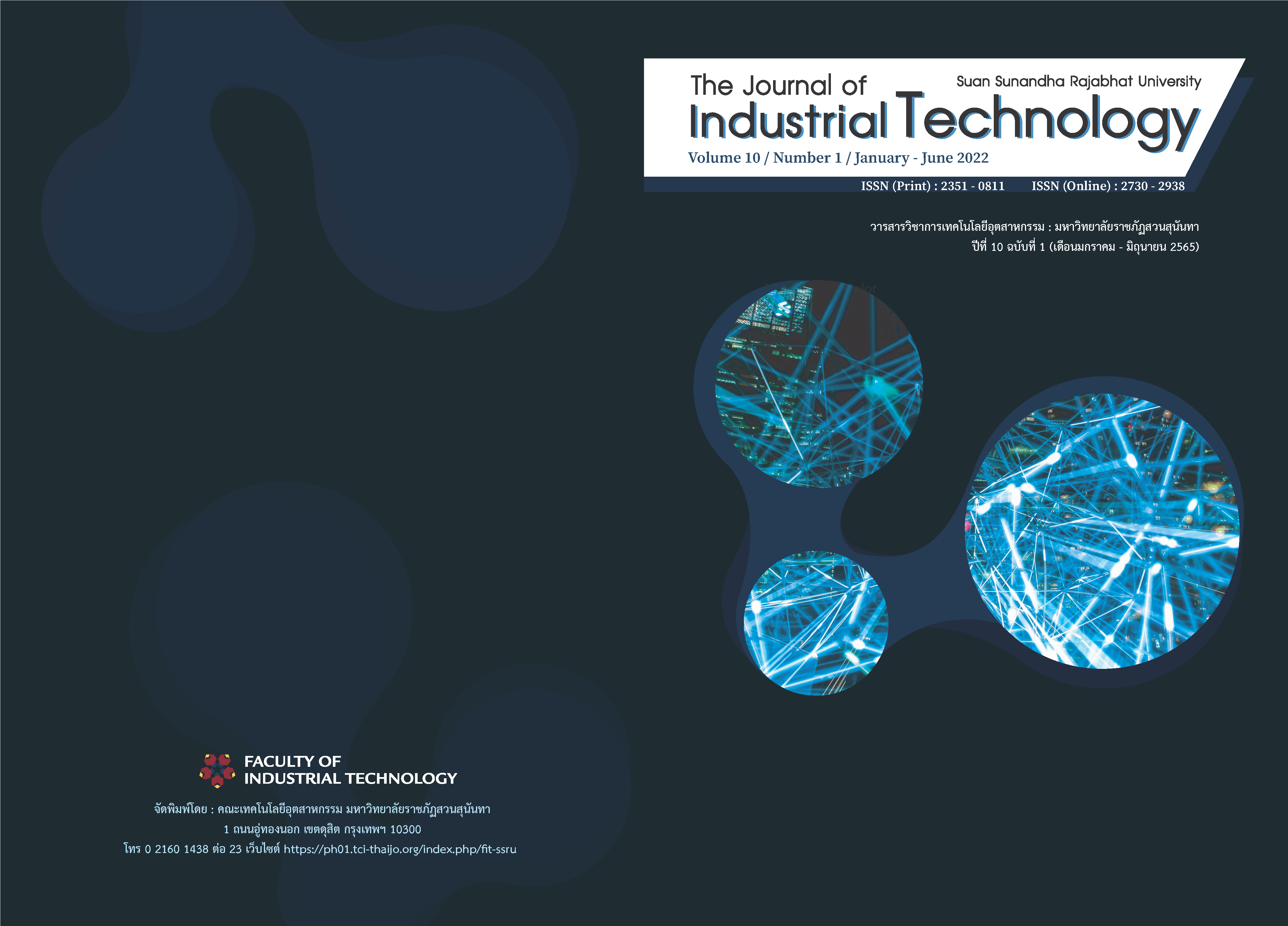The Invention of Semi-automatic Lathe Wood
คำสำคัญ:
semi-automatic lathe machine, lathe wood, teak wood, wear, woodturning knifeบทคัดย่อ
This research aims to study the condition of semi-automatic lathe wood and to develop a semi-automatic lathe wood to be effective in processing wood products. It is an experimental research in which a semi-automatic lathe wood was experimented with eucalyptus, mango, acacia, tamarind and teak wood and their components. The dependent variable and performance level testing are independent variable. From the experimenting of the wood suitability in both the X-axis and Z-axis directions, it was found that duration, length and depth are related to the blade size. The ideal wood for turning is a trial with a 35 mm X-axis blade size. The smallest wood that can be turned is a teak of 22mm. within the specified working time of 4 minutes in the Z-axis coordinate of 40 mm. While the shortest wood turned within the same time is also a teak of 32 mm. In conclusion, a teak is the most suitable wood for turning work; the wear of the wood turning knife in the X-axis, was related to the hardness of the wood which shows that wear varies with the wood hardness; while in the Z-axis, hardwoods as teak and tamarind do more damage to the blade than eucalyptus, acacia, and mango woods. The semi-automatic lathe wood developed by researchers can be used more effectively, faster, and better in production applications for a suitable wood as teak that can provide the smallest and shortest wood. Therefore, this semi-automatic lathe machine can be used in the process of producing sawn timber efficiently and rapidly as a product of the Nasom Village Community.
เอกสารอ้างอิง
Buaphan Prompukping, Theory of technology and modernity, 2nd printing, Khon Kaen : Khon Kaen University, 2014.
Charlie Trakankul, CNC technology, Bangkok: Promotion Association (Thai-Japanese), 2012.
Daniel Lerner, The Passing of Traditional: Modernizing the Middle, New York: Free Press, 1958.
Kongrit Nakhonchai, “Automatic lathe process by using suitable machining conditions,” Master's thesis (Engineering Management Program), Engineering: Burapha University, 2016.
Kua Wongboonsin, Population and development, Bangkok: Chulalongkorn University Publishing, 2015.
Manop Arjphru, Development of a lathe knife holder, Bangkok: Srinakharinwirot University, 2008.
Nirand Chongwuthiwet, and Poonsiri Watjanaphum, Theories and concepts of community development, 3rd printing, Nonthaburi: Sukhothai Thammathirat University Press, 2016.
Paw Wilkinson, Selection of cutting tool materials in metal, New York: Massachusetts Institute of Technology, 1996.
Prasit Pittayapat, Theories related to semi-automatic systems, Automation and control equipment Electricity, 3rd Edition. Bangkok: Expernet, 2013.
Songchai Saetang, Computerized machine control, 3rd printing, Chiang Mai: Chiang Mai University, 2016.
Surasawadeerat Kulchai, Concept and theory of lathe, 4th printing, Bangkok: Chulalongkorn University Publishing, 2016.
Tarinsit Thammacharn, Theories related to semi-automatic systems, Automation and control equipment Electricity, Second Edition. Bangkok: Chulalongkorn University Publishing, 2016.
Theerapong Khanthong, “Improving the efficiency of machines,” independent research degree Master's degree in Industrial Development Department of Industrial Engineering: Thammasat University, 2015.
Thosaporn Sirisamphan, Theory of Dependency Development, Bangkok: Chulalongkorn University Publishing, 2015.
ดาวน์โหลด
เผยแพร่แล้ว
รูปแบบการอ้างอิง
ฉบับ
ประเภทบทความ
สัญญาอนุญาต
ลิขสิทธิ์ (c) 2022 Faculty of Industrial Technology, Suan Sunandha Rajabhat University

อนุญาตภายใต้เงื่อนไข Creative Commons Attribution-NonCommercial-NoDerivatives 4.0 International License.
บทความที่ได้รับการตีพิมพ์เป็นลิขสิทธิ์ของคณะวิศวกรรมศาสตร์และเทคโนโลยีอุตสาหกรรม มหาวิทยาลัยราชภัฎสวนสุนันทา
ข้อความที่ปรากฏในบทความแต่ละเรื่องในวารสารวิชาการเล่มนี้เป็นความคิดเห็นส่วนตัวของผู้เขียนแต่ละท่านไม่เกี่ยวข้องกับมหาวิทยาลัยราชภัฎสวนสุนันทา และคณาจารย์ท่านอื่นๆในมหาวิทยาลัยฯ แต่อย่างใด ความรับผิดชอบองค์ประกอบทั้งหมดของบทความแต่ละเรื่องเป็นของผู้เขียนแต่ละท่าน หากมีความผิดพลาดใดๆ ผู้เขียนแต่ละท่านจะรับผิดชอบบทความของตนเองแต่ผู้เดียว








